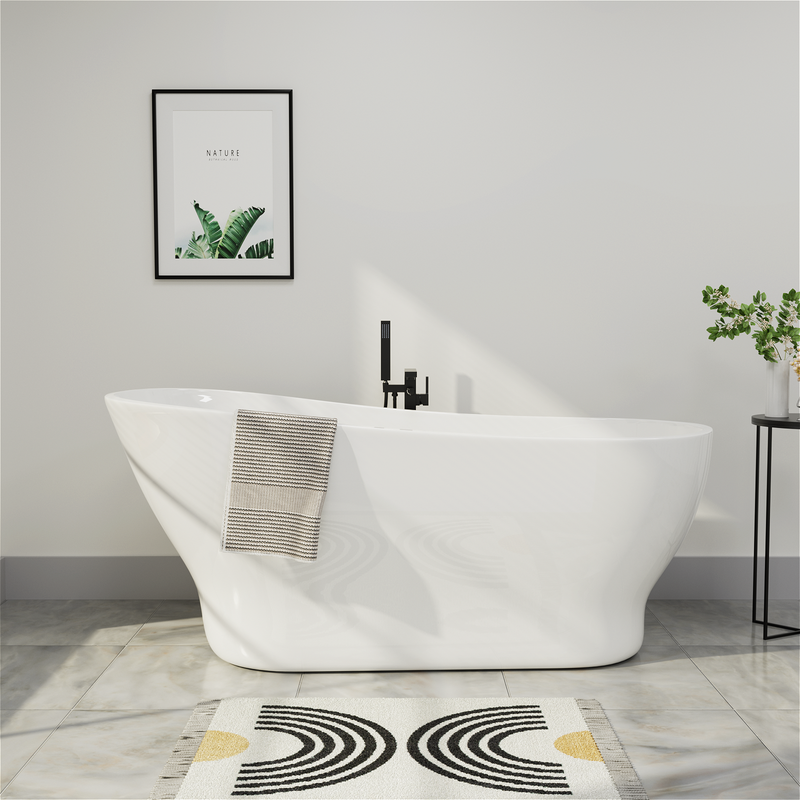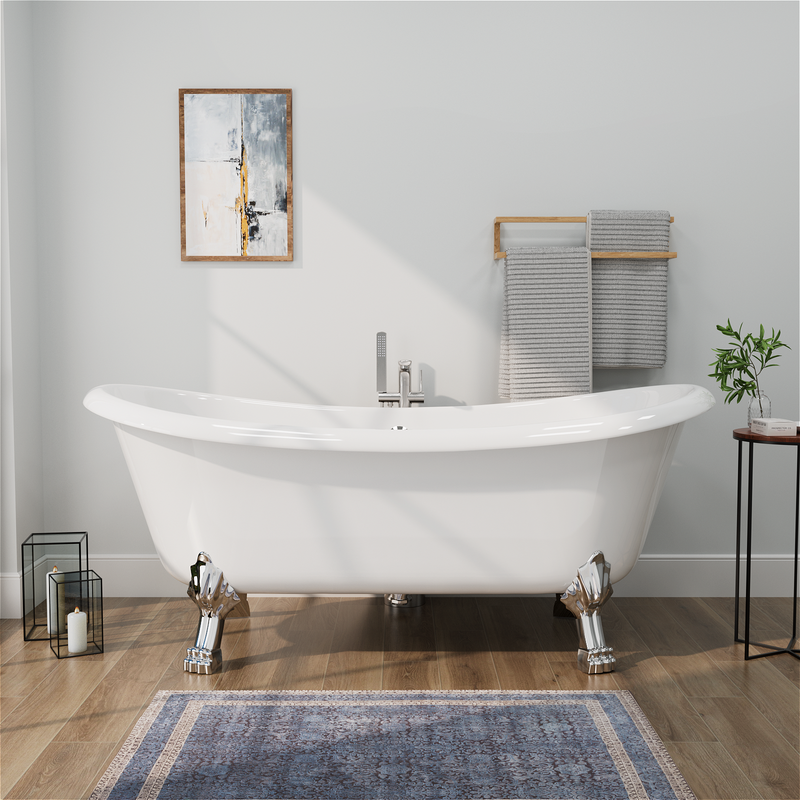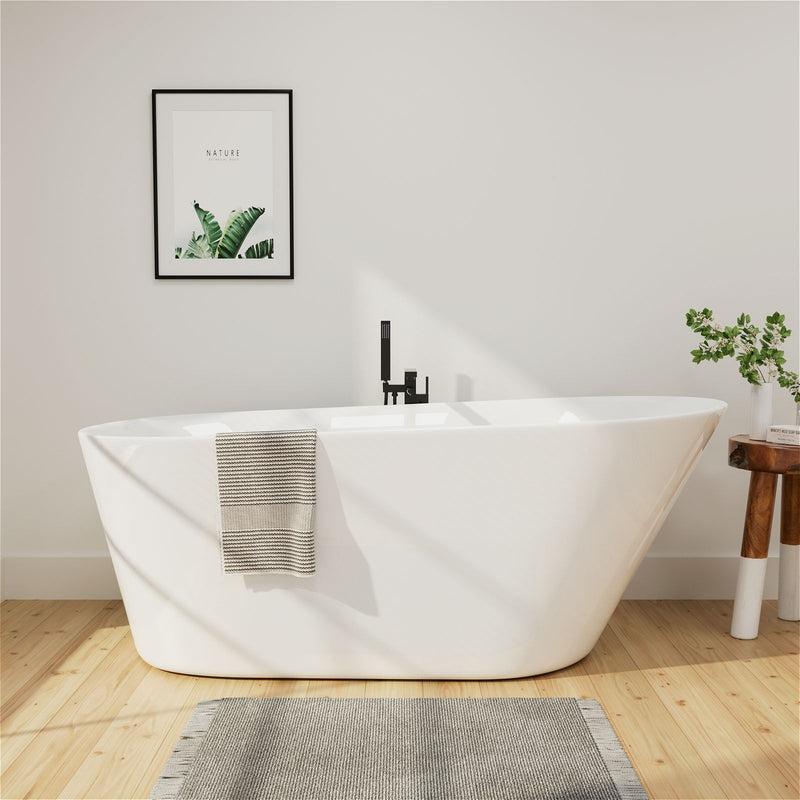Selecting the correct size for an oval bathtub represents one of the most crucial decisions in bathroom planning and renovation. The right choice ensures optimal comfort, functional utility, and aesthetic harmony within the space. An improperly sized tub, whether too large or too small, can compromise both the bathroom's functionality and the bathing experience. This comprehensive guide examines all factors involved in determining the ideal oval bathtub size for your specific needs and space constraints.
The process of selecting the perfect oval bathtub size involves multiple considerations beyond simple measurements. It requires careful evaluation of who will use the tub, how frequently it will be used, what other bathroom fixtures must coexist with it, and what type of bathing experience you desire. By understanding the relationship between physical dimensions, practical requirements, and personal preferences, you can make an informed decision that will provide lasting satisfaction and utility.
Understanding Standard Oval Bathtub Dimensions
Oval bathtubs typically range from 55 to 78 inches in length and 28 to 42 inches in width, with these measurements representing the exterior dimensions that determine how much floor space the tub will occupy. The interior dimensions, which directly impact comfort and usability, vary based on material thickness and specific design features. Standard oval tubs generally provide interior lengths that are approximately 4-6 inches shorter than their exterior measurements, depending on the material and construction quality.

Depth represents another critical dimension, with most oval tubs measuring between 18 and 24 inches deep. Standard soaking tubs typically feature depths around 18-20 inches, while deep soaking bathtubs may extend to 22-24 inches. Deeper tubs allow for more complete immersion, which enhances the bathing experience by keeping more of the body submerged in warm water. The oval shape itself provides distinct ergonomic benefits compared to rectangular bathtubs, as its curved contours naturally align with body positioning better than sharp-cornered alternatives, creating a more comfortable and natural bathing position.
Comprehensive Bathroom Measurement Techniques
Proper measurement of your bathroom represents the essential first step in selecting an appropriately sized oval bathtub. Begin by documenting the room's exact length and width, noting any irregularities in shape or protruding elements that might affect placement. Measure ceiling height as well, particularly if considering a raised tub platform or dramatic waterfall-style faucets. Accurate measurements should account for all permanent fixtures, including toilets, vanities, and existing storage units that cannot be relocated.
Precise measurement must extend beyond the bathroom itself to include access routes. Measure doorways, hallways, and stairwells that the tub must navigate during installation. Many oval bathtubs, particularly freestanding bathtubs, require specific clearance for delivery and installation. Record the exact dimensions of all access points, including their clear opening widths and heights. These measurements will determine whether a particular tub can physically reach its intended location or if special installation procedures will be necessary.
Spatial Planning and Clearance Requirements
Effective bathroom layout requires thoughtful consideration of clearance spaces around the oval bathtub. Most designers recommend maintaining at least 24 inches of clear space in front of the tub for safe entry and exit. For freestanding bathtubs, preserve 3-4 inches between the tub and walls to facilitate cleaning and prevent a cramped appearance. In bathrooms shared by multiple users or serving as primary bathrooms, additional clearance may be necessary to ensure comfortable simultaneous use by different individuals.
Traffic flow patterns significantly influence tub placement and size selection. Consider how people move through the space and what sight lines exist from the bathroom entrance. The tub should be positioned to allow natural movement without creating obstructions or awkward maneuvering. In smaller bathrooms, corner placement often maximizes available floor space while maintaining functionality. Creating a simple scale drawing of your bathroom with the tub positioned within it can help visualize how different sizes will fit and feel in the actual space, revealing potential issues before purchase and installation.
Matching Tub Dimensions to User Requirements
User height represents a primary consideration when determining appropriate oval bathtub size. For individuals measuring over six feet, a tub length of 70 inches or more provides adequate stretching room without cramped positioning. For average-height users or children, compact bathtubs around 60 inches may suffice. Households with multiple users of varying heights should prioritize sizes that accommodate the tallest family member comfortably, as a tub that feels cramped will diminish the bathing experience regardless of other features.
Depth requirements vary significantly with personal preference and physical ability. Those who enjoy complete submersion will appreciate deeper tubs, while people with mobility concerns might prefer shallower bathtubs that are easier to enter and exit. The oval shape naturally provides better back and shoulder support than rectangular designs, but verify that the specific bathtub contours match your preferred bathing position. If you typically read or use electronic devices while bathing, look for designs with back support that facilitates a semi-reclined position comfortably, with particular attention to the angle and curvature of the backrest area.
Material Considerations in Size Selection
The material composition of an oval bathtub significantly influences both its dimensions and practical characteristics. Acrylic bathtubs typically feature thicker walls due to their reinforced construction, which can slightly reduce interior space relative to exterior measurements. Cast iron tubs have thinner walls but significantly greater weight, requiring structural assessment before installation. Stone resin composites offer another alternative, with wall thickness typically falling between acrylic and cast iron while providing substantial durability.
Material choice directly affects heat retention properties, which in turn influences bathing comfort and experience duration. Acrylic maintains water temperature reasonably well while feeling warm to the touch upon entry. Cast iron offers superior heat retention but feels cold initially and requires longer to warm the surface. Stone resin composites balance these qualities with good heat retention and a naturally warm surface. Consider how each material's properties align with your bathing preferences and practical requirements, including maintenance needs, durability expectations, and installation considerations related to weight and structural requirements.
Installation Requirements and Structural Considerations
Freestanding oval tubs require specific plumbing configurations, typically involving floor-mounted faucets and accessible drain connections. Ensure your existing plumbing aligns with the tub's drain location, or factor in the cost of plumbing modifications when budgeting your project. Built-in alcove installations may require additional wall support and waterproofing measures to prevent moisture damage over time. The complexity of installation varies significantly between different tub types and bathroom configurations.
Weight represents a critical installation consideration that directly impacts size selection. A standard acrylic oval tub filled with water can easily exceed 1,000 pounds, requiring adequate floor support. Homes with upstairs bathrooms or older construction should consult a structural engineer to verify the floor can handle this load. Proper installation includes not only securing the tub but also implementing appropriate waterproofing measures around the surrounding area. These considerations may influence maximum size selection, particularly in situations where structural limitations exist that cannot be easily or economically modified.
Optimizing Small Bathroom Layouts with Oval Tubs
Small bathrooms benefit from compact oval tubs designed specifically for limited spaces. bathtubs measuring 55-60 inches long can provide comfortable soaking experiences while occupying minimal floor area. Position these smaller tubs in corners or against the longest available wall to maximize open space. The curved contours of oval tubs often make them appear less imposing in small spaces than similarly sized rectangular bathtubs, creating a sense of openness despite limited square footage.

Incorporate space-saving design elements to enhance functionality in bathrooms with limited dimensions. Wall-mounted faucets preserve precious space around the tub rim while creating a streamlined appearance. Glass shower partitions maintain visual openness in combined shower-tub configurations, preventing the compartmentalized feeling that can make small spaces seem even smaller. Light-colored tiles and large mirrors create illusions of expanded space, making the bathroom feel larger than its actual dimensions. Strategic lighting placement further enhances this effect while providing practical illumination for bathing activities and general use.
Accessibility and Safety Considerations in Size Selection
Proper tub height facilitates safe entry and exit, particularly for older adults or individuals with mobility limitations. Standard tub heights range from 20-24 inches, but people with joint issues may prefer lower-profile bathtubs around 18 inches high. Incorporate grab bars and non-slip surfaces both inside the tub and on the surrounding floor to prevent accidents. These safety features should be integrated into the planning process rather than added as afterthoughts, as they can influence optimal tub size and placement.
Doorway and access path dimensions must accommodate users of all ability levels. The Americans with Disabilities Act recommends at least 36 inches of clear width for main bathroom access routes, though 42 inches better accommodates wheelchair users. These considerations ensure the bathroom remains functional and safe for all household members and visitors throughout its lifetime. When selecting tub size, consider not only current needs but potential future requirements that might arise from changing physical abilities or household composition.
Budget Considerations in Relation to Tub Size
The relationship between oval bathtub size and cost involves multiple factors beyond the purchase price itself. Larger tubs typically command higher prices, but additional expenses may include increased water consumption, higher heating requirements, and potentially more complex installation procedures. When budgeting for a new oval tub, consider these ongoing costs in addition to the initial investment to develop a comprehensive understanding of total ownership expenses.
Installation costs often correlate with tub size and weight. Larger, heavier tubs may require structural reinforcement, specialized equipment for movement and placement, and more extensive plumbing modifications. These factors can significantly impact the total project cost beyond the tub's purchase price. When evaluating different size options, request detailed installation estimates that account for all necessary preparations and modifications to avoid unexpected expenses as the project progresses.
FAQs
What represents the minimum bathroom size for an oval tub installation?
Most oval tubs require at least 4 feet by 4 feet of floor space for comfortable installation and use. Corner installations may work in slightly smaller areas, but always verify specific bathtub dimensions against your available space and consider clearance requirements for safe access and maintenance.
How do I determine the right tub length for my height?
A good guideline involves choosing a tub at least 6-10 inches longer than your height. This provides adequate room for comfortable stretching without feeling constrained. Taller individuals may prefer even greater length margins to achieve a truly comfortable soaking experience without cramped positioning.
What clearance space should I maintain around a freestanding oval tub?
Plan for at least 3-4 inches between the tub and walls for cleaning access. Maintain 24 inches of clear walking space on accessible sides for safe movement. These clearances ensure both practical maintenance and comfortable use while preserving the visual impact of the freestanding design.
Are deeper oval tubs more comfortable for soaking?
Deeper tubs allow more complete submersion, which enhances warmth and relaxation. However, they may present access challenges for some users, requiring careful consideration of individual needs and physical capabilities. Depth preferences vary significantly among different users based on their bathing habits and physical characteristics.
Can I replace my existing alcove tub with an oval freestanding bathtub?
Yes, but this typically requires plumbing adjustments and possibly floor reinforcement. Consult with installation professionals to assess your specific situation, as the complexity of conversion varies depending on existing plumbing configuration and structural conditions.
What material provides the best balance of comfort and practicality?
Acrylic offers favorable heat retention, lightweight properties, and durability, making it suitable for most installation situations and user preferences. Its warm surface feel and design flexibility make it particularly appropriate for residential bathroom applications where comfort and practicality are primary considerations.
How does oval tub comfort compare to rectangular bathtubs?
The curved shape of oval tubs provides more natural body contouring and eliminates pressure points from corners, generally enhancing comfort for extended soaking. The continuous curved surface better accommodates natural body positions than angular designs, contributing to a more relaxed bathing experience.
Conclusion: Achieving the Perfect Fit
Selecting the ideal oval bathtub size involves methodical evaluation of your available space, personal comfort requirements, and practical installation considerations. By taking accurate measurements, understanding standard dimensions, and considering how the tub will function in daily use, you can identify the perfect balance between form and function. The process requires careful attention to multiple factors, but the resulting satisfaction makes this investment of time and effort worthwhile.
The right oval bathtub becomes not just a bathroom fixture but a valued element of your home that provides comfort and satisfaction through years of use. By approaching the selection process systematically and considering both immediate and long-term needs, you can choose a tub that enhances your daily routine and adds lasting value to your living space. The perfect oval bathtub represents a harmonious combination of aesthetic appeal, practical utility, and personal comfort that transforms ordinary bathing into a genuinely rewarding experience.





